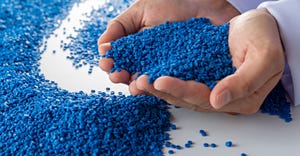Wanted: User friendliness and flexibility
Labor savings is the first reason typically cited, but there are many more reasons for the use of robotics in manufacturing. Robotics have been around long enough that it is ubiquitousin manufacturing,, and certainly within the plastics processing industry, where their use is spreading beyond established applications.
July 14, 2009
Labor savings is the first reason typically cited, but there are many more reasons for the use of robotics in manufacturing. Robotics have been around long enough that it is ubiquitousin manufacturing,, and certainly within the plastics processing industry, where their use is spreading beyond established applications.
For instance, Roberta Zald, director of technology and marketing for KMT Robotic Solutions Inc., says she has seen demand move beyond just the trimming cell from the thermoforming community her company primarily serves. “Many thermoformers are moving to incorporate materials handling automation in their manufacturing cells, particularly those in the heavy gauge sector of that industry,” she says. “They use automation to load the sheet into the thermoformer, then out of the former to the trimmer, and from the trimmer onto a conveyor or a table. We’ve had an increasing requests for this type of expanded automation in thermoforming cells.”
Sepro’s newest robot in its Axxess range is made for small tonnage presses.A Wittmann W633UHS linear top-entry robot with servo drives on all three main axis (X, Y, Z) is integrated into a new component work cell. The robot removes overmolded parts and runners, then separates them onto two conveyors. Wittmann's W631 servo robot equipped with pneumatic wrist flip (c-axis) removes finished parts from a mold for placement in a tray. |
Not only are speed and labor savings of interest to these thermoformers, but in some cases the parts they process are difficult for one person to handle. “Thermoforming operations need consistency in the process, so we’re seeing thermoformers using material handling in ways that protect the quality of the part, particularly with very large parts,” added Zald. “If people take too long to move the part, you lose input from the thermoformer. Using automation also means parts are being trimmed at a more consistent temperature.” Although in many ways it is struggling with the poor market conditions for automotive, housing and appliances, the large parts market also is seen as one that offers some defense against foreign competition, and thus has been one of the safer harbors processors have sought.
Dave Nichols, regional sales manager for robots and IML (inmold labeling) for Wittmann Battenfeld, a manufacturer of robots for injection molding cells as well as auxiliary equipment and injection molding machines, says that while robot use has changed over the years, there still remains plenty of need for his company’s focus, top-entry robots used for degating parts and putting them into a box or onto a conveyor for cooling and/or transfer to a secondary operation. “Robots allow better quality parts with more consistent cycles, which tends to mean less scrap,” he says.
Primarily, processors turn to robots on injection molding machines to reduce labor costs and increase productivity. Reducing scrap rates is also a primary reason for implementing robotic molding cells. “In most cases, if you’re reducing scrap by 5% and molding a high volume of parts, you can get payback on a robotic molding cell in 9-12 months,” estimates Nichols. “With insert molding, that’s a no-brainer. If you’re loading eight inserts by hand, cycles are all over the place, the material is cooking in the barrel – people are inconsistent in a high-speed operation. By putting robots on an insert job, you can double your capacity and get payback rather quickly on a $90,000 to $150,000 investment.”
Doc Breger, automation sales manager for competitive manufacturer Sterling, agrees. “You’d be surprised that something as simple as putting a sprue picker on a press can save you a lot of money,” he says. “We’ve provided work sheets for ROI (return on investment) evaluation on presses with and without a robot. A sprue picker can pay for itself in a month, and lasts 12 years or more. It also allows you to take an operator off the gate and put them in a higher value-added job on the floor.” Integrating the equipment into a processor’s facility is part of the deal, notes Breger, so that, “When we walk away, you’re in production.”
Integrating automation on smaller presses
With typical large part markets such as automotive, white goods and building and construction struggling, the number of manufacturing cells developed around smaller presses and robots is likely to increase, at least as a percentage of all cells in operation. Robot manufacturers have reacted. Sepro America LLC, for instance, recently introduced the smallest robot in its Axess Series, the Axess 7, which began shipping April 1 and is designed for use on injection molding machines sized from 20-80 tons. Jim Healy, VP sales and marketing at the firm, says, “From the beginning, Sepro robots have been designed specifically for plastics applications. Their controls were developed to make it very easy to tie into molding machines, conveyors and other peripheral equipment you find in a work cell.”
Competing supplier Sterling announced the latest addition in its line of automation equipment, the Apex SC-W Series that provides high-speed robotics performance on small tonnage machines (from 50-220 tons). Breger says that the market is “trending toward the smaller tonnage” presses, 500 tons and below, with respect to robots.
“The overwhelming opportunities to automate molding machines are outside the automotive industry, and we’re pushing product that makes sense in this environment,” says Breger. “The high-speed servo units give better throughput and higher production rates, and because it’s a PC-based control environment it eliminates those costs associated with the OEM coming in to do the special functions –you can do it yourself– which means the ROI is shorter.”
Dri-Air Industries also is turning to smaller presses with robotic automation, and announced that its Sytrama robot business has redesigned its G series robots to suit smaller (40-300 ton) injection molding machines. The 61-91 G series robots feature a strip forward design that prevents interference of the strip stroke with machine hoppers, feeders, blenders, and such. To reduce clutter around a press, the new robots also feature a beam-mounted control cabinet.
Charlie Sears, president of Dri-Air Industries, says that although the market for robots in the automotive and white goods industries has slowed, the medical industry is an “area we think is going to grow, since robots are almost imperative in that market.” While Sytrama has been pegged as a large robot producer, medical is a large portion of Dri-Air’s Sytrama customer base, so the company is looking to expand in the medical molding arena, explains Sears.
Another area of growth is electronic connectors. “That’s big for us and we’re expanding that area as well,” says Sears. “Automated manufacturing cells are certainly where more people are concentrating their resources. We’ve seen cells where the interaction of one or more robots is involved, such as with a subassembly insert, overmolding, and particularly in-mold labeling. Those applications are out there and anyone who is cost competitive has to look at that.”
Sears notes that there are “a number of older robots still in the field that are 15 years old or order,” and advises processors that if they have these older robots, it might be a good time to evaluate their productivity compared to the newer robots. “Today the speed is so much faster that in many applications you might be able to increase the output of a cell, and eliminate the need to invest in another cell, just by putting in a new robot,” Sears explains. —[email protected]
About the Author(s)
You May Also Like




